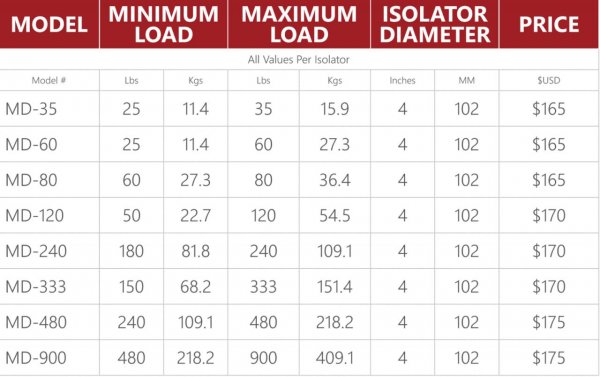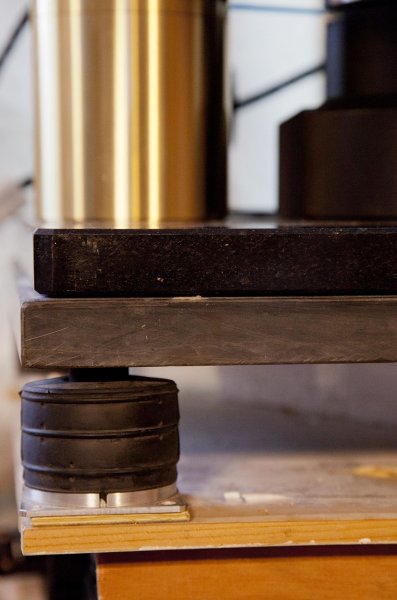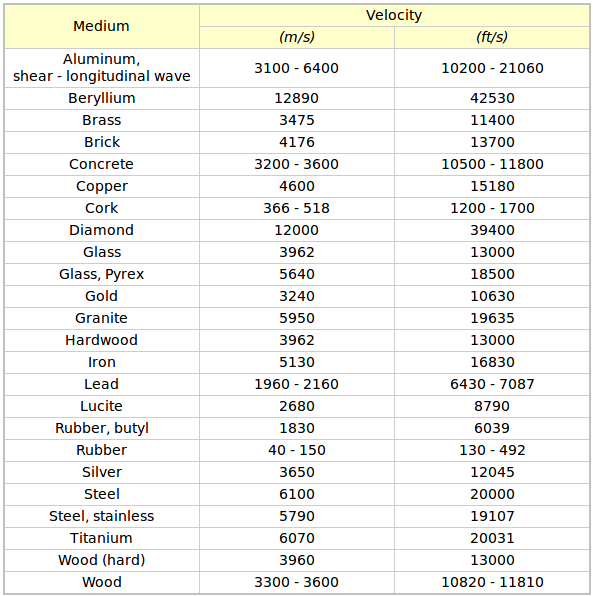http://www.herzan.com/products/passive-vibration-control/microdamp-series.html
Herzan MicroDamp (MD) Series vibration isolators NEW
MicroDamp (MD) Series vibration isolators are an economical solution for applications requiring consistent vibration isolation performance over a broad frequency range. The MD Series consists of a highly compressed composite material encased in damped aluminum, offering significant vibration isolation performance at an affordable price.
MD Series isolators can be easily configured to individual instrument weights, offering a widely applicable solution for instruments between 8-3,600 Lbs. With no air or electricity required, the MD Series is an easy to install, maintenance-free solution that can be designed into a variety of instrument configurations.
Highlights
Affordable and efficient vibration isolation
Minimal amplitude within resonant frequency
Compact, modular form factor
Wide range of supported instrument weights
Easy to integrate into existing instrument setups
No air or electricity required
Cleanroom compatible
Light-weight and easy to install/use
The MD series often utilizes three to four isolators within a vibration isolation platform, depending on the supported instrument’s dimension profile and overall weight distribution. When paired with a damped top plate (i.e. granite, aluminum, breadboard, etc.), the MD Series becomes a complete solution for instruments requiring a stable and reliable vibration isolation platform.
To determine the correct isolator configuration for your instrument, review the MD Series models below and locate the model able to sufficiently support the weight of your instrument.

Please note: the values listed above are for individual isolators only. To correctly select the relevant model for your instrument, multiply the minimum/maximum load capacities by three to determine the total minimum/maximum load capacities. Your instrument must fall within this range to receive optimal vibration isolation performance. If your instrument’s weight does not fall within this range, multiply the minimum/maximum load capacities by a larger number (>3) until your instrument falls within range.
www.herzan.com
Herzan MicroDamp (MD) Series vibration isolators NEW
MicroDamp (MD) Series vibration isolators are an economical solution for applications requiring consistent vibration isolation performance over a broad frequency range. The MD Series consists of a highly compressed composite material encased in damped aluminum, offering significant vibration isolation performance at an affordable price.
MD Series isolators can be easily configured to individual instrument weights, offering a widely applicable solution for instruments between 8-3,600 Lbs. With no air or electricity required, the MD Series is an easy to install, maintenance-free solution that can be designed into a variety of instrument configurations.
Highlights
Affordable and efficient vibration isolation
Minimal amplitude within resonant frequency
Compact, modular form factor
Wide range of supported instrument weights
Easy to integrate into existing instrument setups
No air or electricity required
Cleanroom compatible
Light-weight and easy to install/use
The MD series often utilizes three to four isolators within a vibration isolation platform, depending on the supported instrument’s dimension profile and overall weight distribution. When paired with a damped top plate (i.e. granite, aluminum, breadboard, etc.), the MD Series becomes a complete solution for instruments requiring a stable and reliable vibration isolation platform.
To determine the correct isolator configuration for your instrument, review the MD Series models below and locate the model able to sufficiently support the weight of your instrument.

Please note: the values listed above are for individual isolators only. To correctly select the relevant model for your instrument, multiply the minimum/maximum load capacities by three to determine the total minimum/maximum load capacities. Your instrument must fall within this range to receive optimal vibration isolation performance. If your instrument’s weight does not fall within this range, multiply the minimum/maximum load capacities by a larger number (>3) until your instrument falls within range.
www.herzan.com




